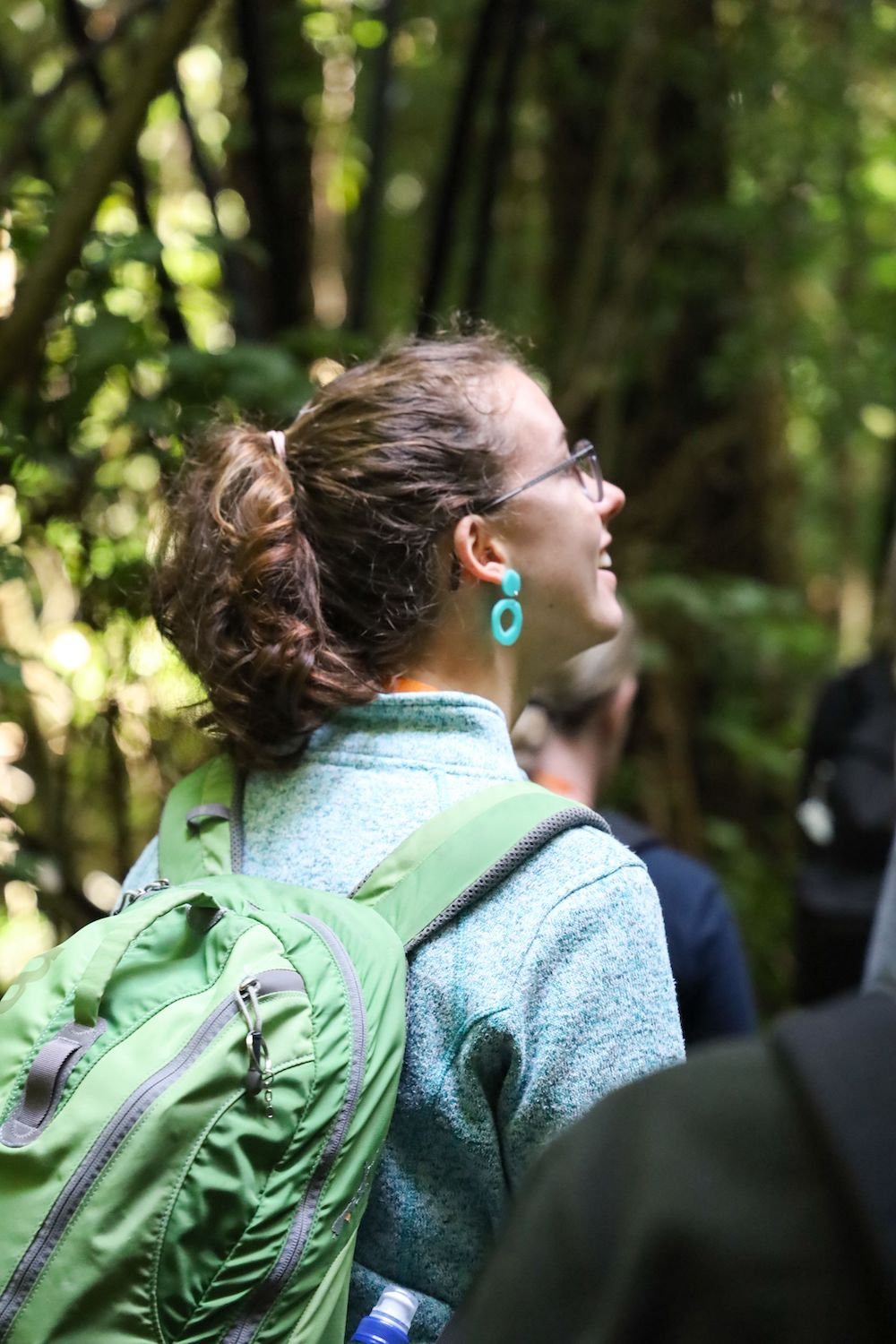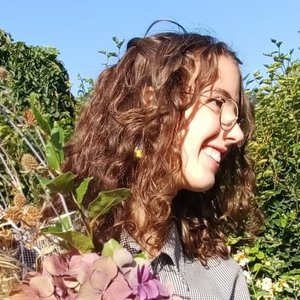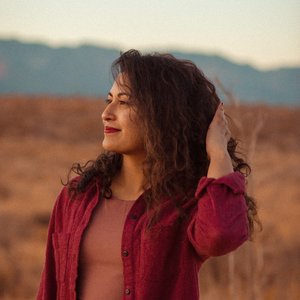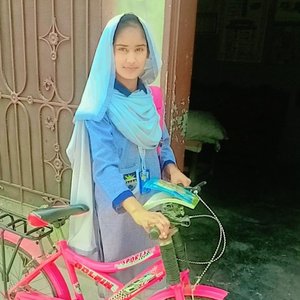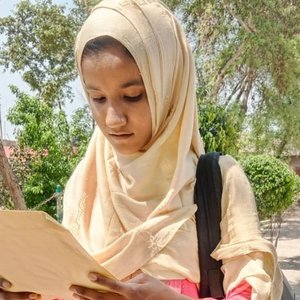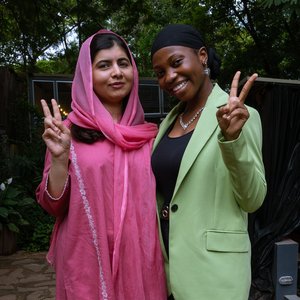A week in the life of a 15-year-old poet and environmentalist in Aotearoa New Zealand
Molly takes us through her adventurous week on an environmental leadership course and shares her love for poetry and community engagement. (Courtesy of Molly Laurence)
Molly takes us through her adventurous week on an environmental leadership course and shares her love for poetry and community engagement.
Monday
Today is my first day at the five-day environmental leadership programme called BLAKE Inspire. I woke up early to catch my flight at 8 a.m. from Christchurch to Auckland. As we drove from the green fields of where we live into the city, my mum and I talked about my hopes for the week.
Being someone whose strengths lie outside of mathematical thinking — which is a strong factor of environmental science and conservation — I had initially worried about being the odd one out or feeling like I took the spot of someone who could do more with it. From what I’ve heard, this is pretty common in activism. Thankfully, time (and my parents) made me realise that ecological conservation is a complex, multi-faceted issue that needs different approaches and different brains to work on it. In the months between getting that email and today, I had time to realise I can bring something and make use of the experience. So that morning, looking out at the road ahead (both literally and figuratively), I was excited and nervous.
Molly and the full “BLAKE Inspire” delegation. (Courtesy of Molly Laurence)
Soon I was safely boarded onto the tiny plane next to the other delegates on my flight. Relieved to meet them and find out they were nice, we arrived a few hours later in Aotearoa’s biggest city and piled onto a bus. After a few more hours of travel through the rolling hills of the North Island, the full delegation was assembled at our accommodation in the Waikato district. We had a quick introduction about what the week would hold and a quick learning of the waiata (Māori song) “Tihei Mauri Ora” that the group would sing to thank our activity facilitators. Then, a video was projected onto the screen.
The video we watched was “I am Aotearoa, Aotearoa is me” by the Ministry for the Environment. It showed sweeping shots of green hills, our blue oceans and a lush native canopy. The voices of the past delegates played, speaking about a Māori whakatauki (proverb):
“Ko au te whenua/awa/moana, ko te whenua/awa/moana, ko au.”
“I am the land/rivers/ocean and the land/rivers/ocean is me.”
The video was powerful and used a whakatauki well to illustrate what could be in a sustainability-focused Aotearoa. It got me thinking about all of the contradictions within society and how talking and doing can be very different things. If we are the land, then why are our native ecosystems collapsing? If our consumerist lifestyle values ourselves above all else, why are we getting hurt? And if we, the rangatahi (young people), are supposedly the most precious thing to society, why is this future inflicted on us?
After watching the video, we all poured onto the bus and headed to a new location for our icebreaker activity. The game was a scavenger-hunt-food-chain simulation that got everyone to run around in the mud of a river island shrieking their heads off. It was a lot of fun. And I think I won! The activity felt like a school camp — we were flitting around laughing, playing the roles of the introduced species that destroy our native biodiversity. But it was cool to be reminded to have some fun while we learn about a serious topic.
After a shaky first proper singing of our waiata, we returned and had dinner at about 6 p.m. I cannot get the tune out of my head and I doubt it will leave. We had a debriefing, after which I called my parents (who were understandably eager to hear about what had happened since they sent their daughter off on a plane to spend a week with a bunch of strangers).
It was about 10:30 p.m. when I finally got into bed and slept the sweet, sweet sleep of the socially exhausted.
Tuesday
At 7:15 a.m., we had breakfast, which was a buffet since we were staying at a boarding school emptied for the holidays. It was delicious. All of us delegates agreed that it’s going to be a brutal adjustment when BLAKE is over.
After that, we were off to our first activity of the day: visiting Maungatautari Sanctuary Mountain. It is one of the largest pest-proof fenced areas of conservation in the world, and is made up of original native bush from before European colonisation. As a result, the established ecosystem was on a much larger scale than other restored bush. With the level of protection offered by the strictly maintained border, some of our endangered species have been reintroduced into the sanctuary area through breeding and conservation programmes! In part due to the effort of those programmes, native bird calls echoed from the greenery up above our heads as we followed a track through the bush.
Molly visiting the Maungatautari Sanctuary Mountain. (Courtesy of Molly Laurence)
Although the Maungatautari Sanctuary Mountain is what most of Aotearoa would have looked like before European colonisation, it is rare and unusual to find such now. Lee, one of our facilitators, taught us some traditional Māori medicinal knowledge about the native plants in the bush. My favourite is the heart-shaped Kawakawa, which has almost every use under the sun. It takes care of bug bites and stomach problems, can be used in dressing wounds and can numb pain in toothaches.
At about 1:30 p.m., we arrived at Dennley Farms for our next activity. The Dennley Farms are sustainable, off-grid sustainable beef and dairy farms and are the National Ambassadors for Sustainable Farming and Growing. This is very important in a nation whose income is mostly from the beef and dairy industry. The owners' actions are inspiring and show the future of sustainable farming in Aotearoa.
The owners encouraged questions and got a (polite) grilling from our group. At this point, I wasn’t feeling great. I’m an introvert and I have ADHD. And although I love experiences like this, one of these activities would usually send me crashing onto the sofa at home afterwards. Having multiple high-energy things like this a day is exhilarating but also exhausting, and intensifies my symptoms.
“I’m an introvert and I have ADHD. And although I love experiences like this, one of these activities would usually send me crashing onto the sofa at home afterwards. Having multiple high-energy things like this a day is exhilarating but also exhausting.”
With my tiredness comes the usual challenge of remaining present and attentive. It’s quite annoying but frustrating when I want to make the most of every moment. I let the others talk and drank some water, and I felt a bit better as we all walked down to the river to look at the riparian planting the farm owners had done on their river banks. Riparian planting is an effective technique for supporting water quality and native wildlife. I would love to implement it at home.
At about 10 p.m., I quickly emailed one of my writing mentors to ask if she’d look at my poems because I had a plan in mind. I then went to bed.
Wednesday
Today we went ZIPLINING! So much fun.
The company we went on with is a partnership between Rotorua Rafting and local iwi Ngāti Pikiao that respects Aotearoa’s Maori culture and sustainable tourism. While we whizzed through treetops and over the water of the Ōkere river, we learned about its history and cultural relevance to the area. As we planted trees to restore the native bush, we learned about the pest-trapping initiatives in the area and how it’s a complicated business, since the pests you catch and prevent from breeding are the ones that are the worst at evading capture. This leaves all the experts out free and breeding more sneaky-offspring that do the same.
“While we whizzed through treetops and over the water of the Ōkere river, we learned about its history and cultural relevance to the area,” Molly shares. (Courtesy of Molly Laurence)
When we got back at 4 p.m., we worked on our action plans and had a briefing on the upcoming policy simulation. Action plans are the specific, measurable, attainable, relevant and time-based (S.M.A.R.T) goals we made to use the skills we learned from this experience in our communities. At 5:45 p.m., we covered Te Tiriti o Waitangi (the Treaty between Māori and representatives of the Crown) and a lesson on climate change. I learned that in 2020, dairy cattle and beef cattle made up 23.5% and 9.0% of Aotearoa’s climate emissions and road transport accounted for 15.3%.
At 6:20 p.m. we had dinner and pink cupcakes for dessert.
Thursday
The day went by fast! We headed off at 8:30 a.m. to a local river to learn how to judge freshwater health. We also learned about the five C’s of water health — Cool, Clear, Clean, Current and Critters — measured pH and water clarity, looked at macroinvertebrates and talked to a freshwater scientist with an impressive amount of snails named after him. A new friend and I took photos and goofed for the camera, pretending to be astounded by a random pebble we’d picked up out of the water.
At 11:45 a.m., we went off to the Whāingaroa/Raglan harbour for kayaking. The harbour is an inspiring example of the long-term benefits of taking environmental action. Since 1995, an organisation called Whāingaroa Harbour Care have grown and planted more than 1.75 million native trees along streams and harbour edges within the Whāingaroa catchment. More than 40 farmers in the area joined to fence and plant out about 450km of riparian areas. Now, Whāingaroa has transformed from what many called one of the worst harbours in New Zealand to one of the best. It’s so heartening to see the positive results of a project, not just the beginnings. It felt like the mauri (life force) of the water has been restored.
“We went off to the Whāingaroa/Raglan harbour for kayaking. The harbour is an inspiring example of the long-term benefits of taking environmental action,” Molly shares. (Courtesy of Molly Laurence)
Paddling in and out of the layered rock formations were an adorable baby seal, a giant jellyfish and a couple of crabs that I am sure were staring at me! There was something incredibly peaceful about being on the water. At 12 p.m., we took some water samples from below the pier and walked down the road with them to a microscope set up in the local library. I had to resist the urge to sit and start reading everything. We looked at the different types of critters there and discussed what they meant for the water’s health.
At 6:30 p.m., we had our last dinner, then a briefing on the next day. It was so weird thinking about how it was the last full day of the course. I didn’t want it to end.
I stayed up that night working on my action plan. I’d been thinking of planting natives along the waterways on our property, but I want to make sure my project is sustainable (for me, not just the environment) and plays to my strengths. I still plan to do riparian planting on the streambanks at home, but I know that if I make it the focus of my action plan, I’ll spend a year feeling guilty about not being out there — while finding it near-impossible to get out there.
A photograph of the “BLAKE Inspire” delegation. (Courtesy of Molly Laurence)
The day still fresh in my mind, I started thinking about how strongly my poetry seemed to connect with people and how this whole programme is about connecting with people and communicating information.
I called my parents and talked through my idea before going to bed past midnight.
Friday
After our final breakfast at 8:30 a.m., where everyone preemptively grieved the loss of the food, it was time to present our action plans. This was the last stage of the programme. Everyone has such amazing ideas, like native planting, school engagement and using cultural values to inspire change. I was so proud of one of my new friends, who was nervous but still shared her awesome plan to educate schools about reducing waste. She sat down and handed me some jasmine she’d picked earlier. I tucked it into my hair as my turn came to present my plan.
Based on the power art has to connect and present well-known issues in a different and emotive light, I plan to use poetry to communicate environmental and climate change science from Aotearoa’s Crown Research Institutes. I’ll do this by producing at least five poems communicating their scientific findings by the 30th of December, 2024, and sharing these findings with communities with limited access to this knowledge. I plan to share this by doing the following: sharing my poems in my school and local district council newsletter, entering poetry anthologies and collections with the pieces written, performing at open mics and public events, and engaging with local and national media. I would have at least 10 interactions over 26 months. I hope it’s not too ambitious, but I want to do something that makes me feel passionate and inspired.
“Near the end, in recognition of the work of all of the facilitators and the Blake Foundation for making the trip possible, I presented one of the poems I had written that week to the Sir Peter Blake foundation,” Molly recalls. (Courtesy of Molly Laurence)
Near the end, in recognition of the work of all of the facilitators and the Blake Foundation for making the trip possible, I presented one of the poems I had written that week to the Sir Peter Blake foundation. I then led the group to sing our waiata of thanks for the final time, to the ones who had taught it to us.
The trip back up to the Auckland airport went fast as I talked to my inspiring new friends about environmentalism, New Zealand climate change poetry and veganism. I realised I couldn’t make myself eat the meat sandwich in my lunch. Then it was sad goodbyes at the airport.
I don’t want to lose the passion that was ignited on this trip. I don’t want things to go back to the way they were before I realised how serious of an issue we face and how possible it is to take action. I feel like I learned the world is ending. But instead of feeling helpless, I feel inspired.
One could almost say “BLAKE” inspired…
Note from the author: I’ve used Aotearoa and New Zealand interchangeably in the above writing. Aotearoa is the most well-known of several Māori names. It translates to Land of the Long White Cloud, after the cloud formation that signalled its presence to Māori seafarers. New Zealand is the English name given by European colonisers.
in this body
in every Health lesson we are taught
consent but if ko mātou te rangi, ko te rangi mātou
if we are the sky and the sky
is us then why do you kiss
80 million tons of carbon dioxide
into our lungs while we try
to pull away?
ko mātou ngā awa, ko ngā awa mātou
we are the rivers and the rivers are us
we know our history
is rich with contradictions but
that doesn’t explain the pain of
trying to grow up water-wild
‘round blue veins pricked
dark with toxins a tattoo
we never wanted
tracing all the futures
we’ll never get
ko mātou te ngāhere, ko te ngāhere mātou
we are the forest and the forest is us
I guess it figures. all the scars we try to hide, chainsaw
teeth at our lungs, we gasp
for air
Mehemea ko tātou te whenua nei,
ko te whenua nei ko tātou kē
if we are this land
and this land
is us then tug
at each intertwine
of our braided rivers, brown roots streamside
exposed, everything we have
call yours. i’m not sure/shore
we’d call this relationship symbiotic
or healthy , in life or biologoy we smile
with bread tags and microplastics gritted
between our pebble teeth, hold bottle top bruises
in the expanse of our arms
throw them out wide
and say
this is us
 Read more
Read more






